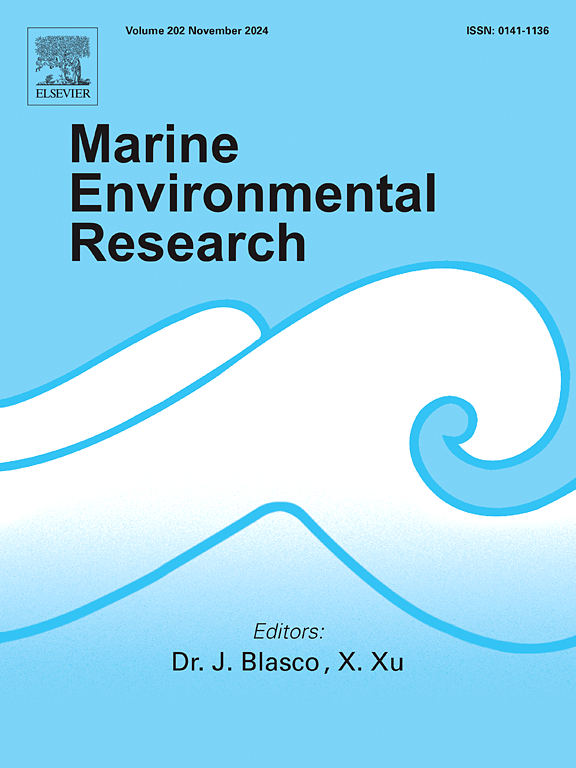Gut microbiota and metabolic functions in herbivorous fish from Xisha coral reefs, China
IF 3
3区 环境科学与生态学
Q2 ENVIRONMENTAL SCIENCES
引用次数: 0
Abstract
Herbivorous fishes are the major consumers of macroalgae on coral reefs. Macroalgae are then degraded by fish gut microbiota. Despite the importance of this process, there remains a lack of information about the gut bacterial community of herbivorous fishes in coral reefs. This study examined the composition and potential metabolic functions of gut microbiota through full-length 16S rRNA amplicon sequencing for coral reef fish species from the Xisha islands of China, including five herbivorous species (Naso unicornis, N. lituratus, N. brevirostris, Ctenochaetus striatus, and Siganus argenteus) and one carnivorous species (Myripristis kuntee). The composition of the gut bacterial community and potential functional genes were observed and significant differences were identified between herbivorous and carnivorous fish species. The bacterial diversity (Shannon and Simpson indexes) in herbivorous fish was significantly higher than in carnivorous fish. Clostridium was significantly more abundant in carnivorous fish than herbivorous fish (p < 0.05). Conversely, Niameybacter, Alistipes, Desulfovibrio, and Akkermansia were more abundant in herbivorous fish (p < 0.05). These bacterial genera, which are shared among herbivorous fish, are believed to play crucial roles in macroalgae metabolism. A principal coordinate analysis further revealed that the gut bacterial composition of the five herbivorous fish species could be divided into two distinct clusters, which was influenced by selective feeding behaviors on different macroalgae types. Functional analysis of gut bacteria in herbivorous fishes showed a high abundance of carbohydrate metabolism pathways. Through comparison with the carbohydrate-active enzyme (CAZy) database, eight glycoside hydrolases (GHs) and one glycosyltransferase (GT) were identified in herbivorous fishes, providing further insights into the roles of gut microbiota in macroalgae metabolism. This study provides valuable insights into the roles of the gut microbiota in herbivorous fishes with regard to metabolizing various types of macroalgae.
西沙珊瑚礁草食性鱼类肠道菌群及代谢功能
草食性鱼类是珊瑚礁上大型藻类的主要消费者。大型藻类随后被鱼类肠道微生物群降解。尽管这一过程很重要,但关于珊瑚礁中草食性鱼类肠道细菌群落的信息仍然缺乏。本研究通过对中国西沙群岛珊瑚礁鱼类的16S rRNA全长扩增子测序,研究了其中5种草食性鱼类(Naso unicornis、N. lituratus、N. brevirostris、Ctenochaetus striatus和Siganus argenteus)和1种肉食性鱼类(Myripristis kuntee)肠道微生物群的组成和潜在代谢功能。观察了草食性鱼类和肉食性鱼类肠道细菌群落的组成和潜在的功能基因,发现两者之间存在显著差异。草食性鱼类的细菌多样性(Shannon和Simpson指数)显著高于肉食性鱼类。肉食性鱼类中梭状芽孢杆菌的含量明显高于草食性鱼类(p <;0.05)。相反,在草食性鱼类中,Niameybacter、Alistipes、Desulfovibrio和Akkermansia的含量更高(p <;0.05)。这些细菌属在草食性鱼类中共享,被认为在大型藻类代谢中起着至关重要的作用。主坐标分析进一步表明,5种草食性鱼类的肠道细菌组成可划分为两个不同的集群,这一集群受对不同类型巨藻的选择性摄食行为的影响。对草食性鱼类肠道细菌的功能分析表明,它们具有丰富的碳水化合物代谢途径。通过与碳水化合物活性酶(CAZy)数据库的比较,在草食性鱼类中鉴定出8种糖苷水解酶(GHs)和1种糖基转移酶(GT),为进一步了解肠道菌群在巨藻代谢中的作用提供了依据。本研究为草食性鱼类肠道微生物群在代谢各种大型藻类方面的作用提供了有价值的见解。
本文章由计算机程序翻译,如有差异,请以英文原文为准。
求助全文
约1分钟内获得全文
求助全文
来源期刊

Marine environmental research
环境科学-毒理学
CiteScore
5.90
自引率
3.00%
发文量
217
审稿时长
46 days
期刊介绍:
Marine Environmental Research publishes original research papers on chemical, physical, and biological interactions in the oceans and coastal waters. The journal serves as a forum for new information on biology, chemistry, and toxicology and syntheses that advance understanding of marine environmental processes.
Submission of multidisciplinary studies is encouraged. Studies that utilize experimental approaches to clarify the roles of anthropogenic and natural causes of changes in marine ecosystems are especially welcome, as are those studies that represent new developments of a theoretical or conceptual aspect of marine science. All papers published in this journal are reviewed by qualified peers prior to acceptance and publication. Examples of topics considered to be appropriate for the journal include, but are not limited to, the following:
– The extent, persistence, and consequences of change and the recovery from such change in natural marine systems
– The biochemical, physiological, and ecological consequences of contaminants to marine organisms and ecosystems
– The biogeochemistry of naturally occurring and anthropogenic substances
– Models that describe and predict the above processes
– Monitoring studies, to the extent that their results provide new information on functional processes
– Methodological papers describing improved quantitative techniques for the marine sciences.
 求助内容:
求助内容: 应助结果提醒方式:
应助结果提醒方式:


